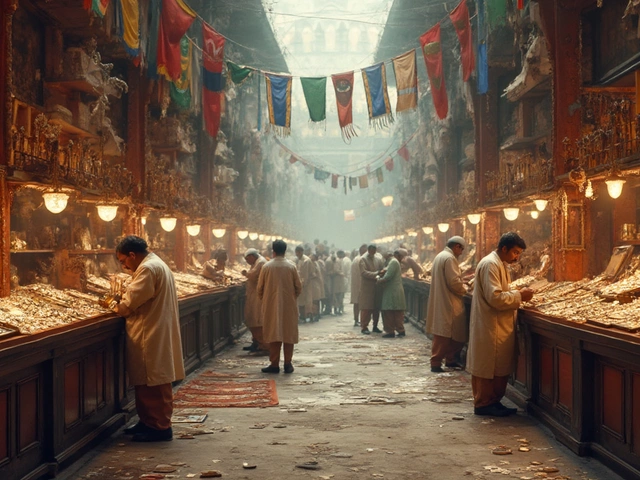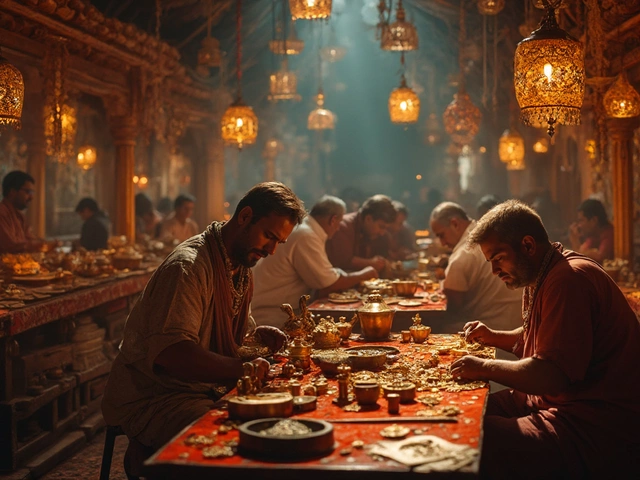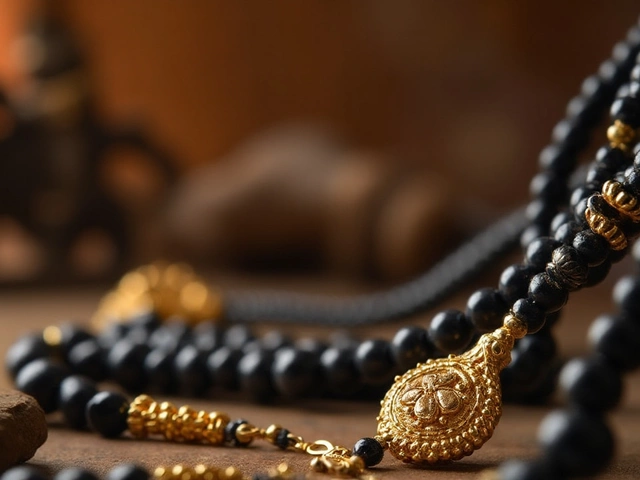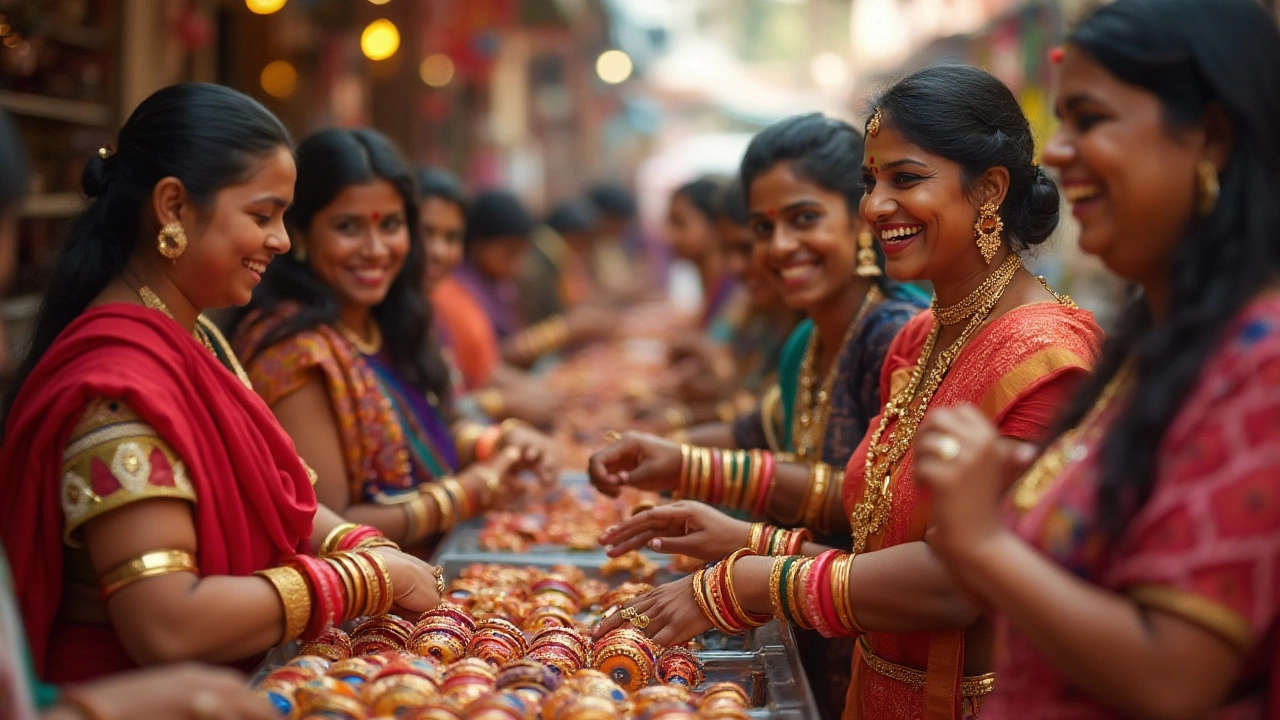
Bangles and chooda are not just pieces of jewelry; they're vibrant expressions of Indian tradition and identity. While they both grace the wrists of women, they come with distinct histories, cultural meanings, and styles that set them apart. Bangles, often worn in multiples, can be found in various materials like glass, gold, silver, and even lac, resonating with a tinkling charm that whispers of tradition and beauty. On the other hand, chooda, primarily associated with Punjabi and North Indian weddings, holds a more ceremonial role.
Typically made of ivory or adorned with red and white hues, the chooda is more than just an accessory; it's a symbol of marital joy and bliss. This difference between the everyday allure of bangles and the special significance of a chooda set defines their unique place in the tapestry of Indian culture. These traditional ornaments continue to captivate hearts, transcending their original regions to become a beloved part of bridal fashion across the country.
- Historical Significance
- Cultural Symbolism
- Material and Craftsmanship
- Regional Variations
- Fashion and Modern Adaptations
Historical Significance
The journey of bangles through history is a fascinating tale that connects us to ancient civilizations and their cultural ethos. Archaeological remnants from the Indus Valley Civilization, dating back to 2600 BC, have unveiled bangles made of terracotta, shell, copper, and glass, revealing their deep-rooted origins in the Indian subcontinent. These artifacts show that bangles were not merely fashion accessories but carried cultural and religious importance, symbolizing femininity, marital status, and sometimes even wealth and prosperity.
Bangles find mentions in ancient texts and scriptures, including the Ramayana and Mahabharata, where their jingling sounds often accompany the descriptions of beauty and grace. They were cherished as much in the past as they are today, becoming timeless emblems of continuity and tradition. An ancient Indian text notes, "The resonance of a woman's bangles echoes the warmth of home and hearth," encapsulating their role in day-to-day life.
In contrast, the tradition of wearing chooda traces its origin to Northern India, prominently among Punjabi communities. Historically linked with weddings, chooda sets mark the initiation of marital bliss, with colors and designs lending them a unique identity. The tradition dictates that a bride wears these for a specific period post-marriage, embracing the cultural nuance of new beginnings. Perhaps surprisingly, chooda represents both the continuity of social customs and personal metamorphosis that marriage brings.
Interestingly, the bangles’ transition into modern-day fashion owes much to their historical adaptations and the inherent charm that stems from antiquity. While the chooda remains a cultural relic of matrimony, bangles dance across borders of time and geography, welcoming infinite reinterpretations. This synthesis of history and modernity ensures both bangles and chooda remain vibrant symbols in the colorful tapestry of Indian culture.
Cultural Symbolism
Bangles and chooda carry profound cultural significance in various parts of India, serving as symbols of tradition, marital status, and even spiritual beliefs. For many, wearing these pieces transcends mere adornment. Bangles, often worn by women from childhood to old age, embody a continuous circle of life and are believed to promote harmony and boost energy levels. In particular moments, such as during religious ceremonies and festivals, the bangle acts as more than just a decorative item—it becomes a talisman of sorts, nurturing positive vibrations and protecting against negative forces.
The chooda, on the other hand, is heavily linked to marriage, primarily in the northern regions of India. It is an integral part of a bride’s attire and is believed to herald new beginnings, prosperity, and long-lasting happiness in her married life. Typically, a new bride wears the chooda for several weeks to months post-marriage, a conspicuous reminder of her transition into married life. Such traditions are not without significance or sentiment. Each bangle within the chooda set carries wishes for joy and prosperity, its red and white hues symbolizing purity and energy. The chooda is often accompanied by a ceremony that marks this transition, highlighting its importance and the solemnity with which it is adorned.
The cultural symbolism of bangles and chooda doesn’t stop at their wearers. These adornments often reflect the skill and artistry of the local craftspeople who produce them. From the making of glass bangles in Firozabad to the intricate gold bangles sold in Rajasthan, these items bear the hallmark of a rich cultural heritage. With a nod to this craftsmanship, Mahatma Gandhi once reflected on the artistic legacy of such work, saying, "Art that made these bangles is an inborn skill that every artist carries from the cradle to the grave." In this way, each bangle is not just a piece of jewelry but a testament to the cultural and artistic wealth of India.
Throughout the regions and communities of India, many variations of bangles exist, each with distinct cultural associations. In Bengal, women wear a combination of conch shell and red coral bangles known as Shakha Pola, believed to bring good fortune. Meanwhile, in Maharashtra, green glass bangles are emblematic of prosperity and fertility. Such regional specificity in bangle types stems from deep-rooted cultural practices and age-old beliefs passed down through generations. It's not uncommon for families to maintain collections of heirloom bangles, handing down these precious pieces to younger generations as a way of passing on tradition and family history.
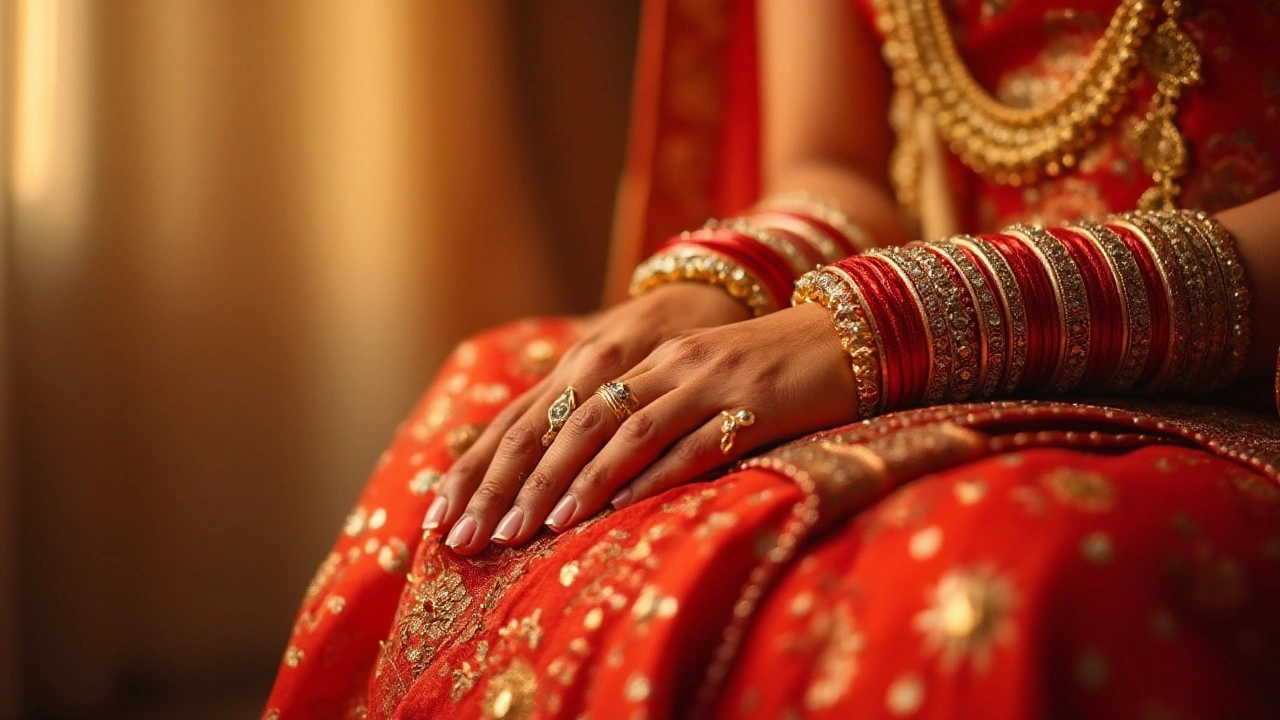
Material and Craftsmanship
When we delve into the world of bangles and chooda, the materials and craftsmanship behind these beautiful ornaments reveal an intricate tapestry of tradition and skill. Bangles are crafted in myriad materials, each bringing its unique charm to the mix. The most common materials used are glass, lac, gold, silver, and even now, modern alloys and plastics. Glass bangles, with their myriad colors, are perhaps the most widely recognized, famous for their satisfying tinkling sound that accompanies every movement of the wrist.
Craftsmen, who have inherited the art of bangle-making over generations, meticulously cut and smooth each piece. Lac bangles, popular in regions like Rajasthan and Hyderabad, are molded over flames, an ancient technique that requires immense precision. Meanwhile, gold and silver bangles often showcase intricate carvings and inlays, sometimes set with precious stones or enamel work. Each element is woven together to create a masterpiece that’s not just a piece of jewelry but a testament to the artisan’s skill and the wearer’s status.
On the other hand, chooda holds a special place with its own distinct identity. Traditionally made of ivory, modern adaptations now commonly use lightweight plastic to mirror its creamy finish. These bangles are resplendent in shades of red and white, each color symbolizing purity and prosperity. The process of crafting chooda involves attention to size and sequence, with each set carefully constructed to fit perfectly on a new bride's wrist. This meticulous process highlights the collaborative effort between artisans and families to create the perfect bridal accessory.
In the words of Harshita Sharma, a cultural historian, "Jewelry serves as a timeless bridge between the past and future, each piece forged in the fire of tradition and adorned with the passion of its craftsman." This rings especially true for bangles and chooda, where the artist's dedication is palpable in every curve and motif. With modern fashion trends, materials may evolve, but the soul of these traditional ornaments remains unchanged, continuously captivating with their blend of beauty and heritage.
The charm of these traditional pieces continues to thrive globally, enticing fashion enthusiasts and cultural aficionados alike. The balance of ancient techniques with contemporary innovations ensures that both bangles and chooda remain relevant, wearable art that nods to their stunning history while forging forward into the modern age. The world of bangles and chooda is a vibrant testament to the unyielding beauty of Indian artistry, resplendent with stories etched in every design.
Regional Variations
India, with its diverse cultural tapestry, offers a rich variety of traditional jewelry pieces like bangles and chooda, each region lending its unique flavor to these ornaments. Across the states, these adornments take on distinct forms, colors, and styles reflective of local customs, traditions, and even geographical characteristics. In Rajasthan, for instance, the vibrant hues and intricate designs of bangles are directly inspired by the state’s colorful festivals and historic heritage. Rajasthani women often wear bangles made of lac, an age-old art, known for its lightweight yet robust nature, imbibing them with the spirit of the Thar desert.
In contrast, South India is famed for its love of gold. Here, bangles are not just ornaments but also symbols of prosperity and auspiciousness. Kerala, known as 'God's Own Country', embraces the elegance of flat gold bangles often worn during festive occasions and weddings. The lush, green landscape of Kerala inspires the craftsmanship, resulting in pieces that are as exquisite as the backwaters that cradle this region.
Transitioning northwards, the chooda is a staple in places like Punjab and Haryana, integral to the wedding ceremony. These regions favor bangles made of ivory or white and red plastic, signifying love and prosperity. Each set of chooda is distinct, with accompanying 'kalire' – decorative hangings – symbolizing life's bounty and blessings. A popular saying in Punjab captures this sentiment:
"The louder the chooda, the happier the marriage," revealing a cultural belief in the chooda's spiritual significance.
Moreover, in Gujarat, the craftsmen often incorporate mirror work and colorful threads into bangles, showcasing the state's lively dance forms and cultural ethos. In Kolkata, where tradition meets flamboyance, the 'shakha pola' — shell and red coral bangles — are integral to Bengali weddings, embodying promises of longevity and fortune. A unique aspect is the way these bangles connect families, becoming heritage pieces passed down through generations.
This delightful diversity not only underscores the artistic prowess native to different Indian regions but also highlights how each locality resonates its own identity through these pieces. Whether it's the North's symbolic chooda or the South's gold-draped symphony, each bangle tells a story steeped in tradition, weaving a narrative that travels through time, binding the past, present, and future.
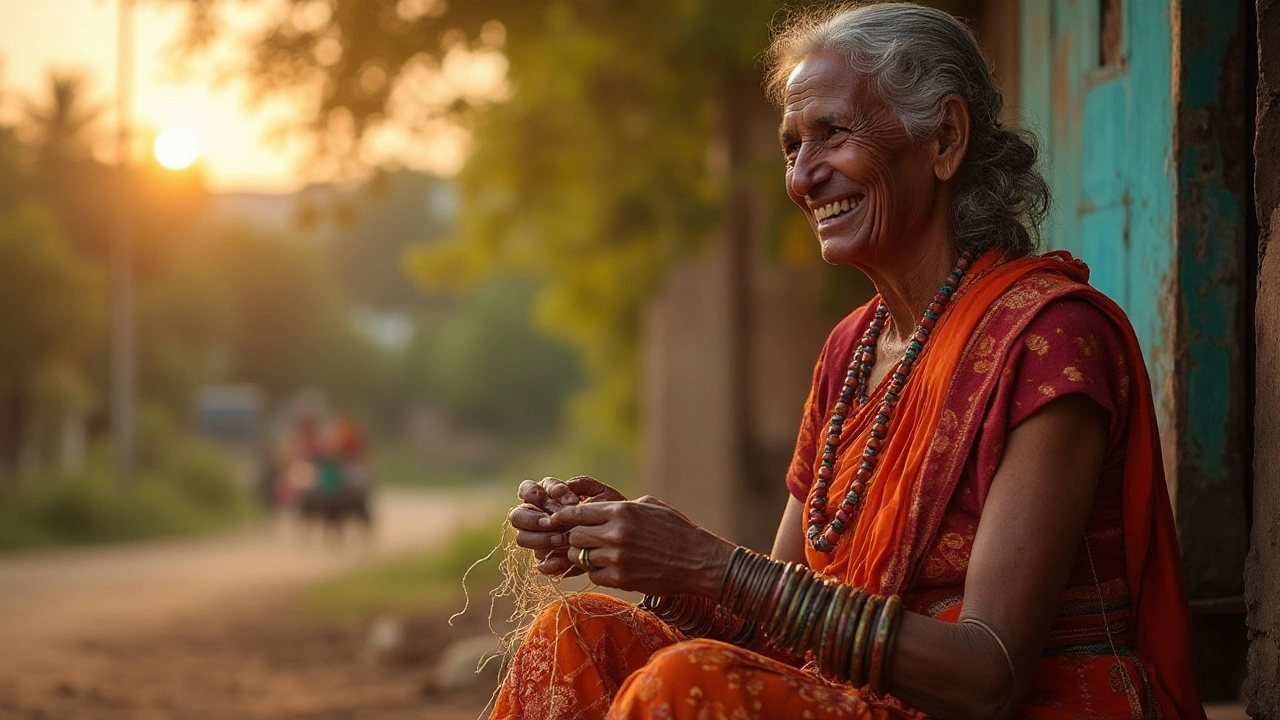
Fashion and Modern Adaptations
In recent years, the world of traditional jewelry has witnessed a fascinating interplay between time-honored customs and contemporary aesthetics. The bangles and chooda of India are at the heart of this transformation. These cherished artifacts, deeply rooted in cultural practices, are being reimagined to suit the tastes and preferences of the modern woman while still holding onto their authentic essence. Designers are weaving innovation with tradition, creating pieces that tell stories of the past while embracing the trends of the present and future.
This fusion of tradition and modernity is evident in how choodas, once solely part of bridal attire, are now being worn by women outside of matrimonial contexts, highlighting their evolving symbolism. Artisans are experimenting with novel materials beyond the customary red and white hues, incorporating metals, stones, and even recycled elements to create designs that resonate with eco-conscious fashion enthusiasts. Bollywood and social media influencers play a significant role in popularizing these adaptations, often seen flaunting these pieces in ways that inspire followers to do the same.
It's worth noting how the integration of technology has transformed the bangles market, making it more accessible to a global audience. E-commerce platforms, virtual reality, and augmented reality toolkits allow buyers to experience the visual and tactile allure of these jewels from the comfort of their homes. The global diaspora of Indian communities has also popularized these ornaments internationally, making them a trendy addition to diverse wardrobes around the world. This cross-pollination of styles has led to exciting collaborations between Indian craftsmen and international designers, resulting in collections that honor the elegance of Indian artistry while appealing to a cosmopolitan audience.
Interestingly, there is a rise in bespoke jewelry services, where individuals commission customized bangles and chooda to match personal tastes or significant life events. This trend signifies a shift from mass production back to personalized, meaningful fashion that resonates with the narrative of the wearer.
According to jewelry designer Sabyasachi Mukherjee, "The modern bride seeks pieces that complement her individualistic spirit, reflecting her journey, dreams, and values." This sentiment underscores the evolution of traditional ornaments into versatile accessories that cater to diverse lifestyles.Designers are also responding to the growing demand for inclusivity, offering a range of sizes to accommodate different wrist shapes and sizes, further enhancing the appeal and accessibility of these beautiful pieces.
Exciting collaborations between high-end luxury brands and local artisans have led to a renaissance in the production of bangles and chooda, with exquisite designs that accentuate the beauty of handcrafted precision. The ethical and sustainable aspects of jewelry production are increasingly taking center stage, with many consumers preferring ethically sourced materials and transparent manufacturing processes. This commitment to sustainability not only preserves the rich heritage of Indian craftsmanship but also promotes responsible consumption. Enthusiasts now have the opportunity to invest in pieces that are not only aesthetically pleasing but also environmentally conscious, making them proud owners of ornaments that carry significant cultural and ecological value.
